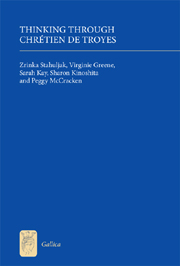Book contents
- Frontmatter
- Contents
- Preface
- Introduction
- 1 The “Changeful Pen”: Paradox, Logical Time, and Poetic Spectrality in the Poems Attributed to Chrétien de Troyes
- 2 Imagination
- 3 Adventures in Wonderland: Between Experience and Knowledge
- 4 Feudal Agency and Female Subjectivity
- 5 Forgetting to Conclude
- Epilogue
- Appendix I Sigla of the Principal Manuscripts of the Chrétien Romances
- Appendix II Lyric Texts, Textual Notes and Translations
- Appendix III Passages from Cligés for Comparison with Lyric Texts
- Appendix IV Variants to the “Cart Scene” in Le Chevalier de la Charrete
- Bibliography
- Index
- Title in the Series
2 - Imagination
Published online by Cambridge University Press: 05 February 2013
- Frontmatter
- Contents
- Preface
- Introduction
- 1 The “Changeful Pen”: Paradox, Logical Time, and Poetic Spectrality in the Poems Attributed to Chrétien de Troyes
- 2 Imagination
- 3 Adventures in Wonderland: Between Experience and Knowledge
- 4 Feudal Agency and Female Subjectivity
- 5 Forgetting to Conclude
- Epilogue
- Appendix I Sigla of the Principal Manuscripts of the Chrétien Romances
- Appendix II Lyric Texts, Textual Notes and Translations
- Appendix III Passages from Cligés for Comparison with Lyric Texts
- Appendix IV Variants to the “Cart Scene” in Le Chevalier de la Charrete
- Bibliography
- Index
- Title in the Series
Summary
Being the best knight in the world, Lancelot does not need magic to defeat his adversaries, cross dangerous bridges, or resist the assaults of assertive damsels. He simply uses his physical strength, courage, military skills, endurance, and exceptional ability to focus on one and only one object of desire. In the Charrete, there is an exception to this rule, a magic ring that Lancelot received from his fairy foster mother. The stone of this ring “had such a power that no spell could bind him once he had looked at the stone” (tel force avoit / Qu'anchantemanz ne le pooit / Tenir, puis qu'il l'avoit veüe; ll. 2337–9). The first time Lancelot makes use of the fairy's gift, he and his two companions are trapped in a castle after two doors fall down behind their heels and in front of their noses. Looking at his ring, he can see that “there is no spell here” (il n'i a point d'anchantemant; l. 2353). The doors do not magically open since they had not been magically closed. Or, alternatively, the illusion that closed doors bar their way out does not vanish since real doors are really closed, a de facto bar to their way out. Lancelot and his companions will escape by breaking the wooden beam blocking a small postern with their swords (ll. 2356–60). It remains unclear why they came to believe they were under a spell and not between closed doors.
- Type
- Chapter
- Information
- Thinking Through Chrétien de Troyes , pp. 41 - 74Publisher: Boydell & BrewerPrint publication year: 2011

